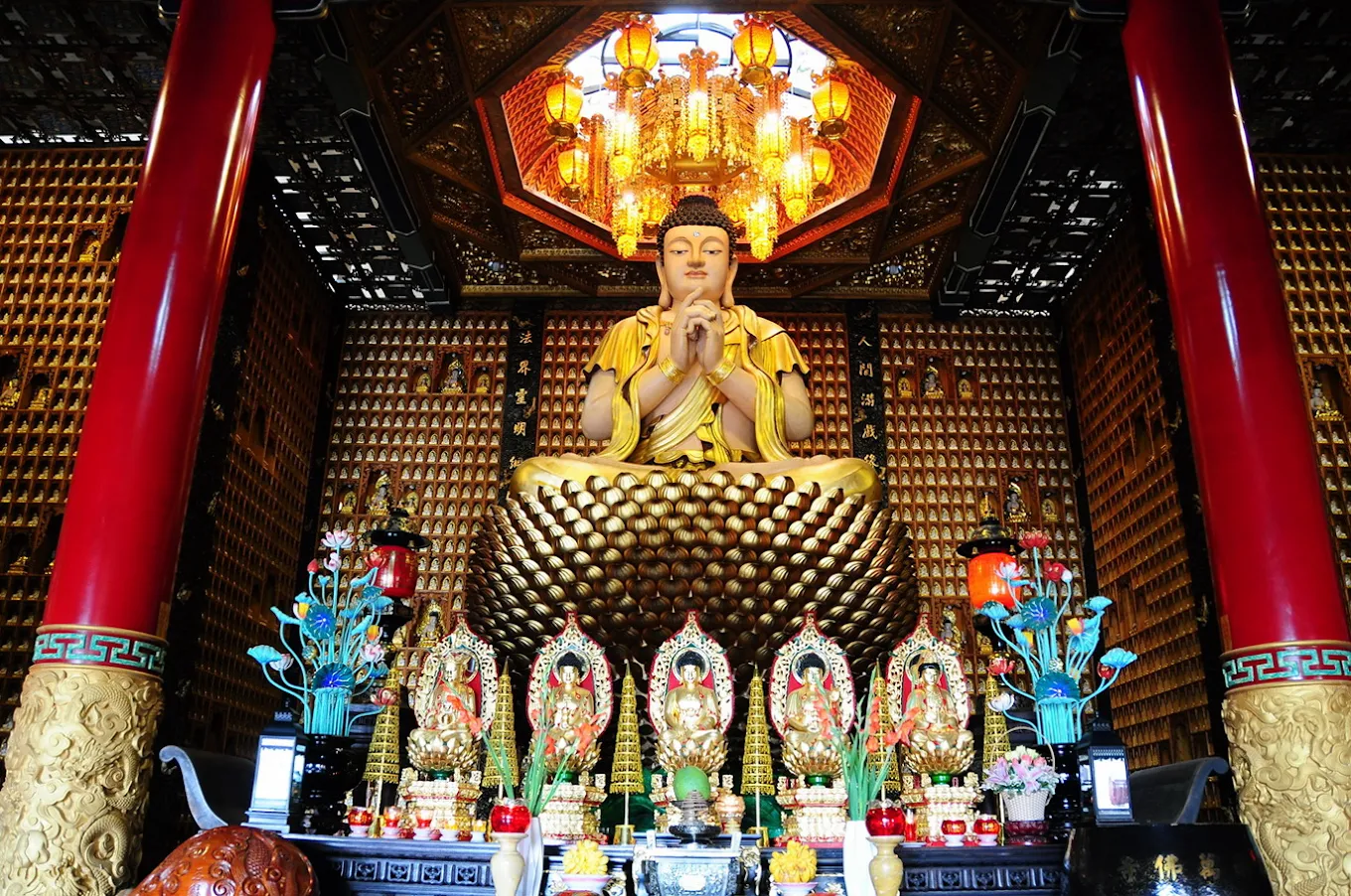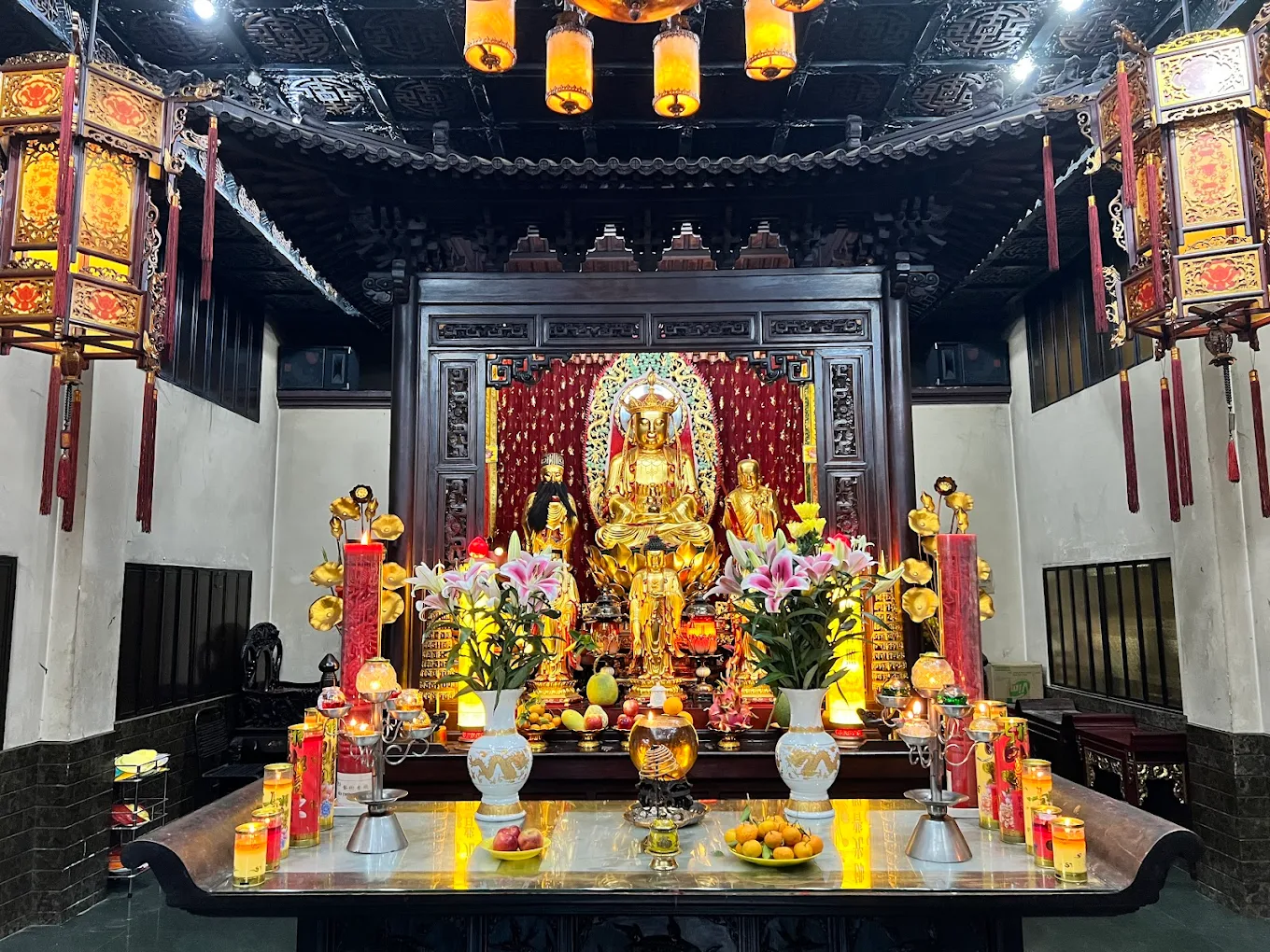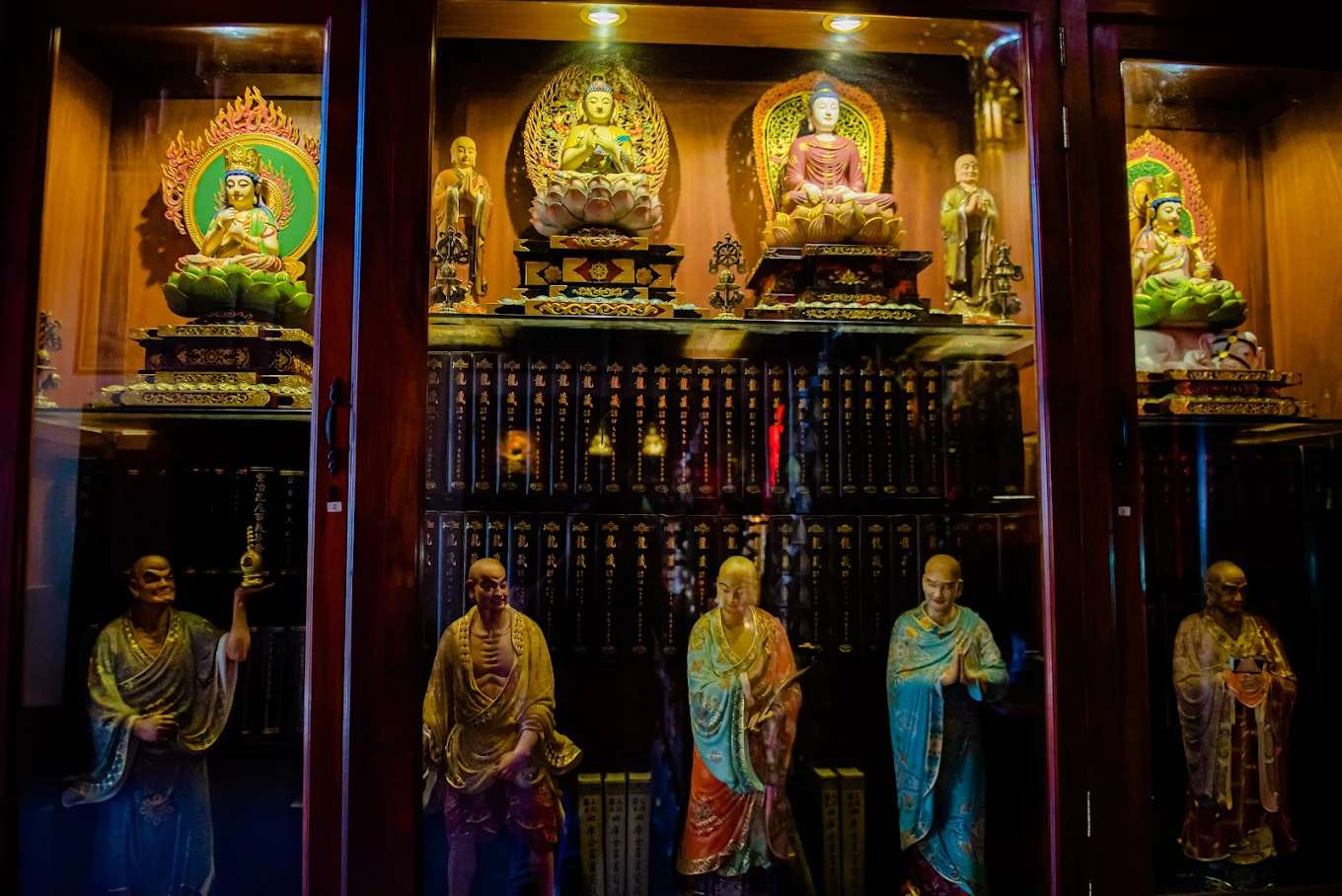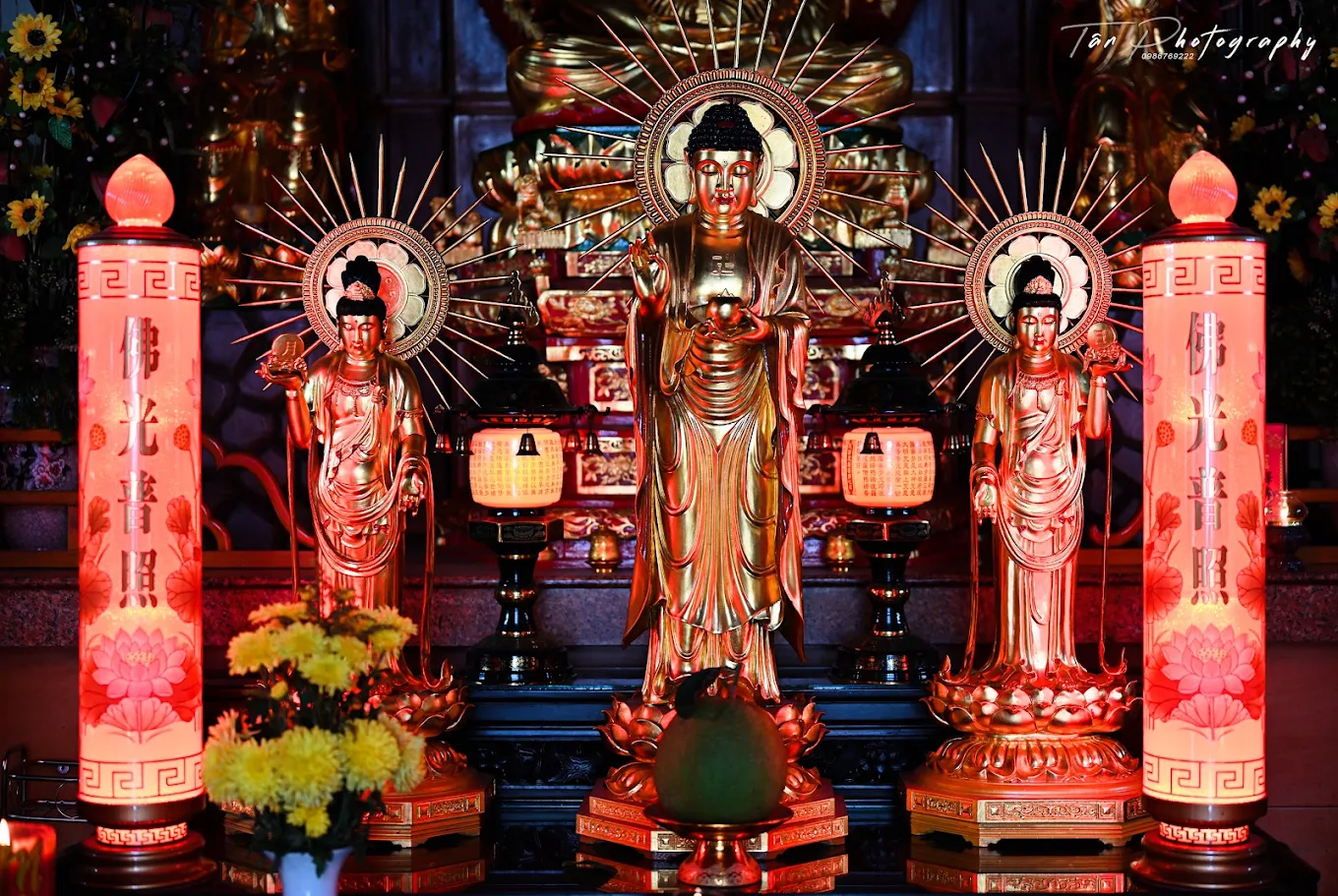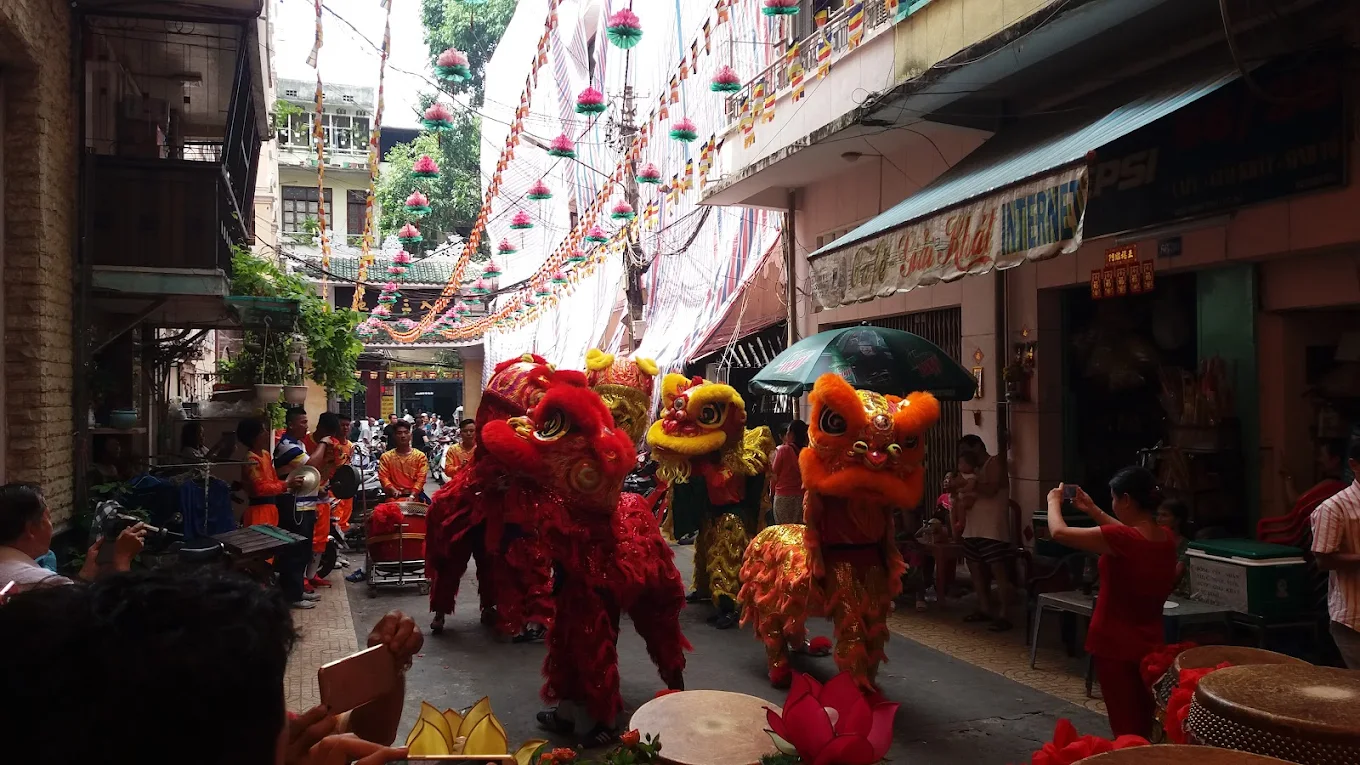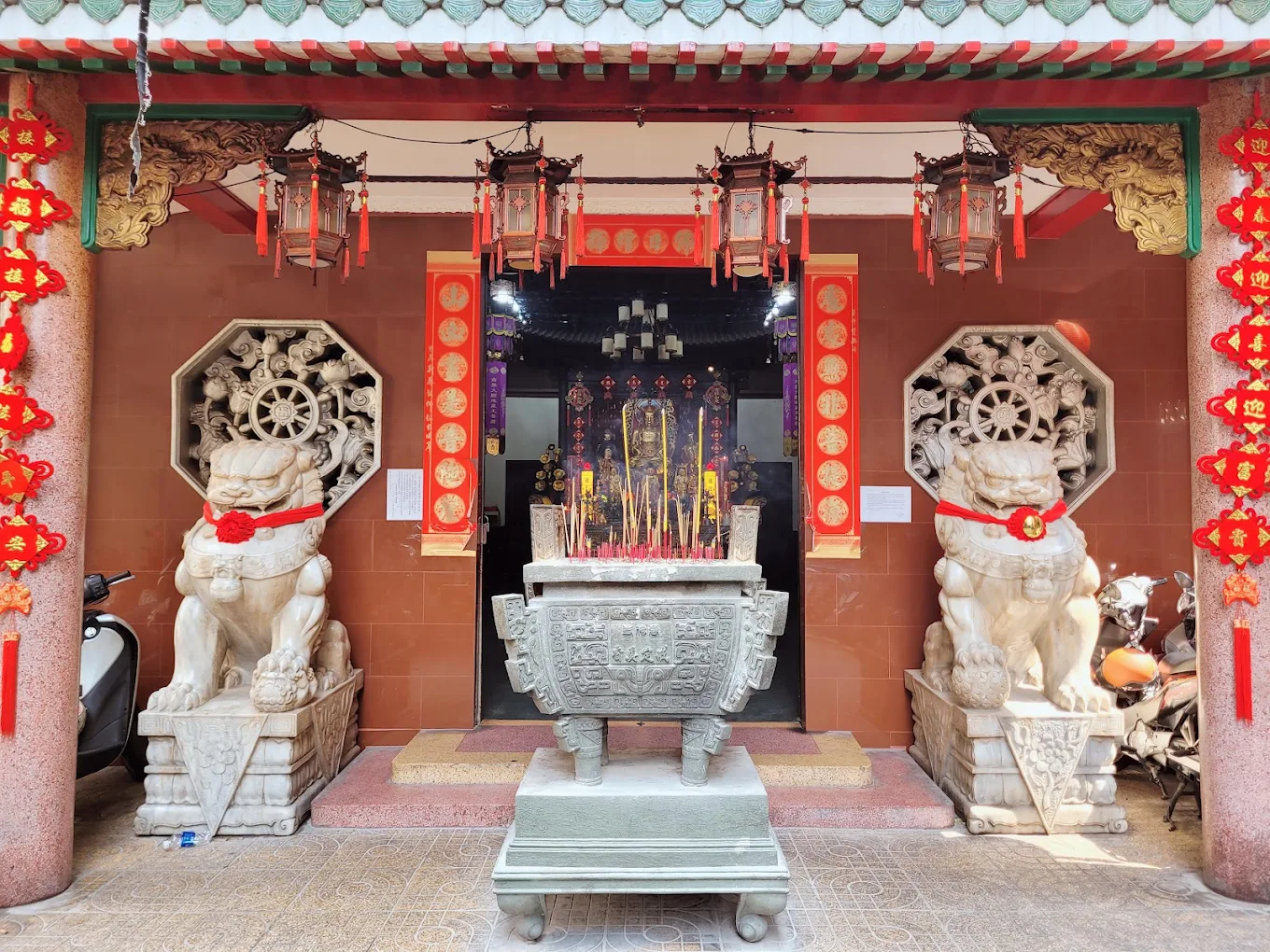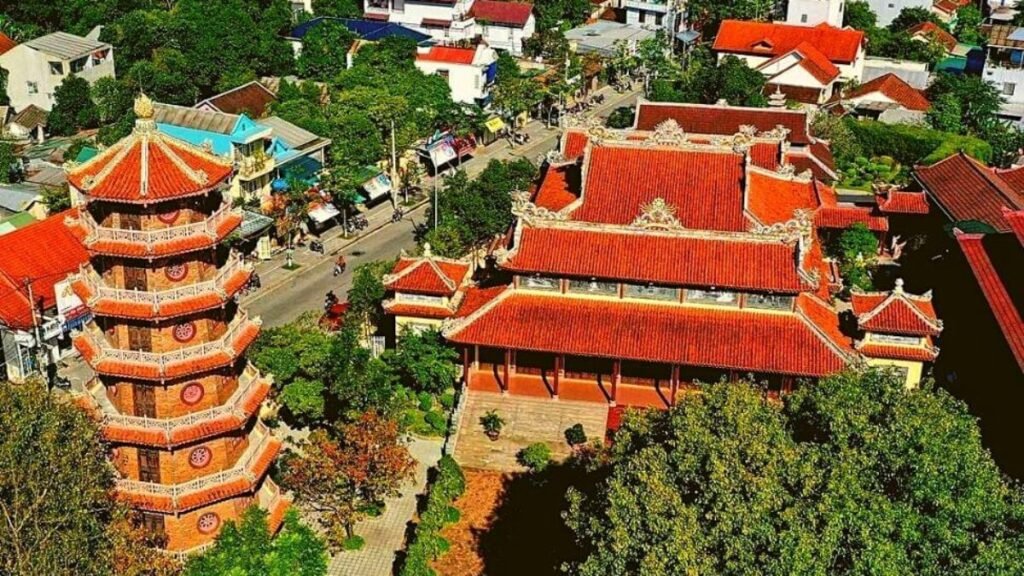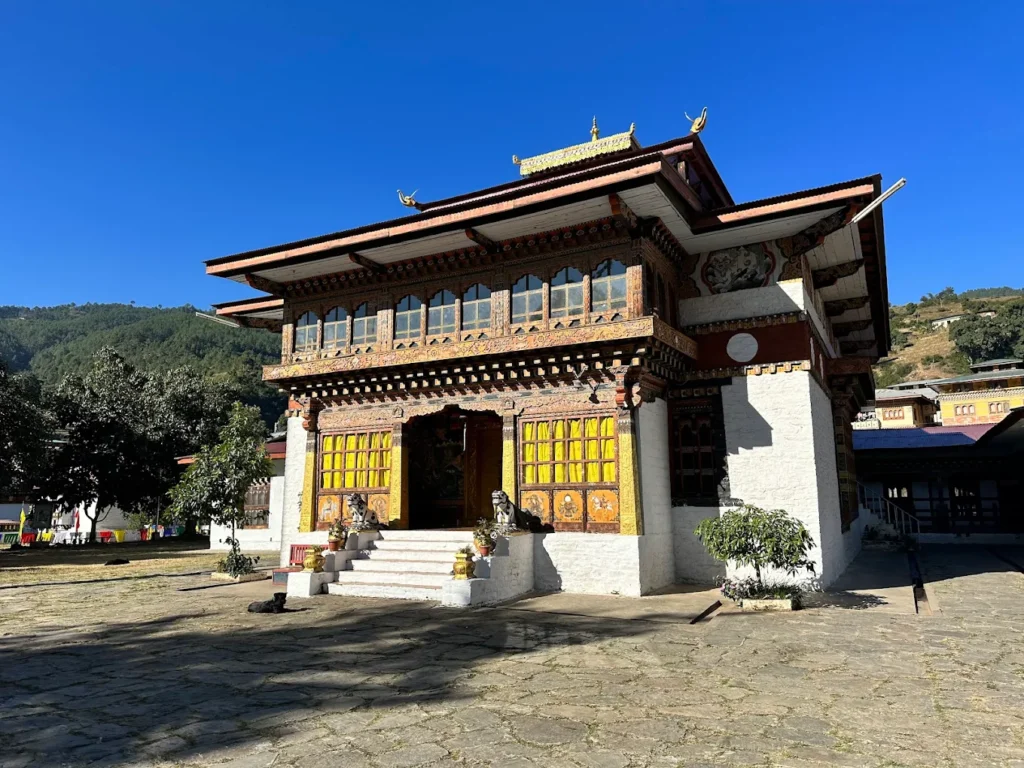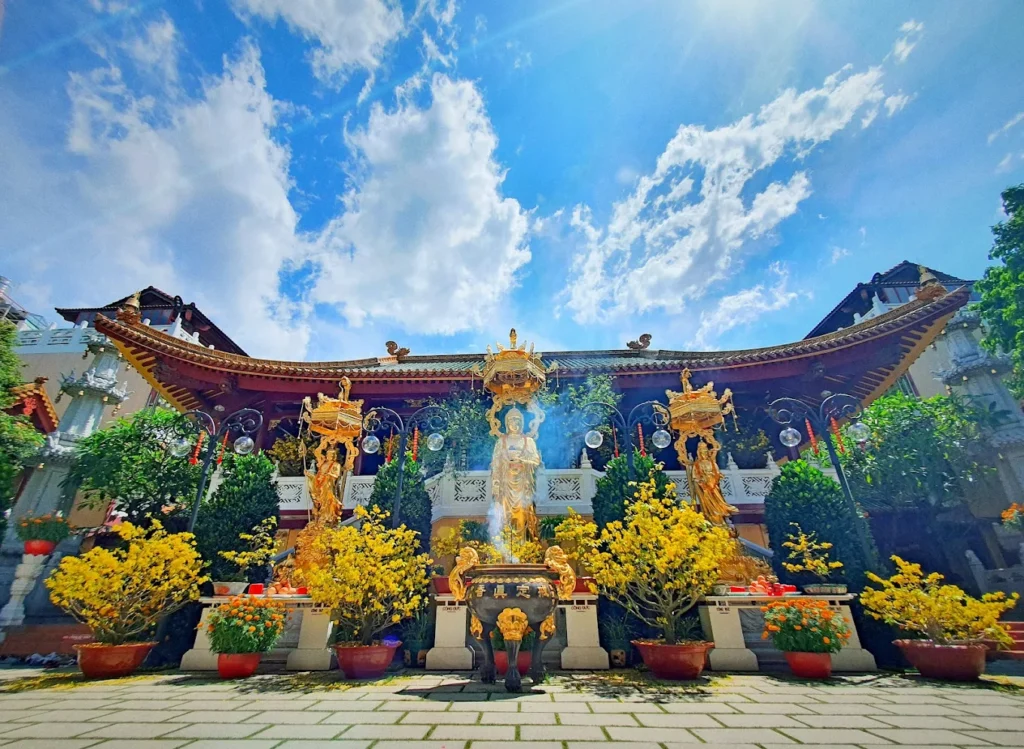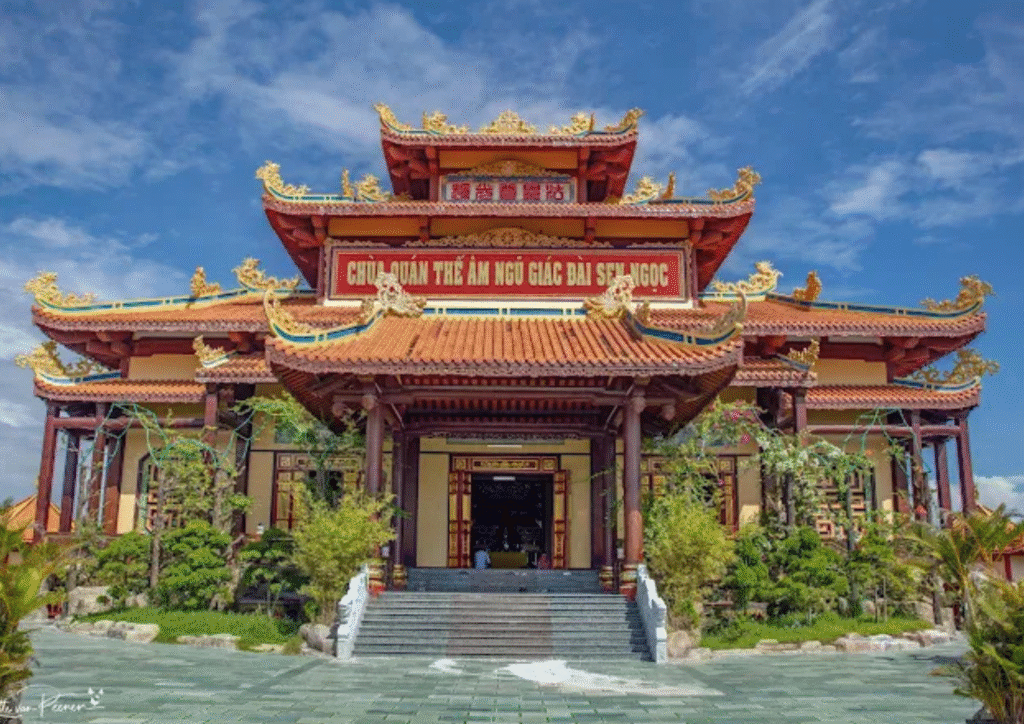Vạn Phật Pagoda: The Sacred Haven of Ten Thousand Buddhas in District 5’s Heart
Tucked within a narrow alley off Nghĩa Thục Street, the vibrant pulse of District 5 softens as a temple bell’s resonant chime welcomes visitors to Vạn Phật Pagoda [Chùa Vạn Phật], meaning Temple of Ten Thousand Buddhas, reflecting the Northern Mahayana ideal of boundless compassion. Saffron-robed monks arrange butter lamps [đèn bơ] before a towering Buddha Shakyamuni, his serene countenance radiating calm amid a sea of over 10,000 miniature Buddha statues lining the walls. The warm glow of red lanterns and the delicate scent of sandalwood incense fill the air, harmonizing with the rhythmic chants of the Medicine Buddha Sutra [Dược Sư kinh], a Northern Mahayana prayer for healing and peace. The temple’s five-story structure, adorned with intricate ceramic carvings [khắc gốm], culminates in the Universal Light Hall [Phổ Quang Minh], a radiant testament to the Chinese Buddhist community’s devotion. Nestled near Hòa Bình Market, this sacred haven offers tranquility amid Ho Chi Minh City’s bustle, inviting visitors to explore Vạn Phật Pagoda’s serene heritage.
Overview and Significance
Introduction to Vạn Phật Pagoda
Vạn Phật Pagoda, a cornerstone of Northern Mahayana Buddhism in Ho Chi Minh City’s District 5, stands as a vibrant testament to the city’s Chinese Buddhist heritage, renowned for housing over 10,000 miniature Buddha statues, a record recognized by the Vietnam Record Organization. Founded in 1959 by Venerables Đức Bổn and Diệu Hoa, two monks of Chinese descent, the temple embodies the Mahayana ideal of boundless compassion, where practitioners seek enlightenment for all sentient beings. Northern Mahayana, or Bắc Tông, emphasizes wisdom, compassion, and the bodhisattva path, principles woven into the temple’s rituals, Chinese-inspired architecture, and community life. The temple draws thousands annually for prayer, meditation, and festivals, blending East Asian architectural elegance with Vietnamese vibrancy. Its serene ambiance, tucked within the bustling Chợ Lớn area, offers solace to locals, pilgrims, and global visitors, cementing its role as a spiritual landmark.
The temple’s significance extends beyond its physical presence, serving as a bridge between the Chinese diaspora and Vietnamese Buddhist traditions. Its five-story structure, crowned by the Universal Light Hall, reflects a fusion of Cantonese aesthetics and Northern Mahayana spirituality, with red lanterns and ceramic carvings evoking a sense of reverence. The oracle stick machine [máy xin xăm], a unique feature, draws devotees seeking divine guidance, blending traditional Chinese practices with modern curiosity. Vạn Phật Pagoda’s ability to harmonize cultural diversity with spiritual unity makes it a focal point for those seeking to explore Vạn Phật Pagoda, offering a sanctuary where the sacred and the communal intertwine.
Historical Journey
Vạn Phật Pagoda’s history weaves a rich tapestry of resilience and devotion, reflecting the Chinese Buddhist community’s enduring legacy in Ho Chi Minh City’s Chợ Lớn. In 1959, Venerables Đức Bổn and Diệu Hoa established the temple as a modest sanctuary for Chinese Buddhist monks and devotees, providing a space for meditation and study during Vietnam’s post-colonial era. Initially a single-story structure with a simple altar, it served as a spiritual refuge for the Chinese diaspora amid the vibrant markets of District 5. The original building, constructed with wooden beams and a tiled roof, housed a modest Buddha Shakyamuni statue, surrounded by a handful of miniature Buddhas, offering a quiet space for prayer in a time of social upheaval. By the 1970s, as the Chinese community in Chợ Lớn grew, the temple expanded to accommodate increasing visitors, adding space for communal prayers and rituals, including a larger altar for the Buddha Shakyamuni statue, marking its rise as a spiritual center in District 5.
From 1998 to 2008, under Venerable Thích Truyền Cường’s leadership, the community funded a major renovation, expanding Vạn Phật Pagoda into a five-story structure with the Universal Light Hall. This ambitious project, driven by grassroots donations from local Chinese families, vendors, and artisans, reflected their devotion despite economic hardships. Many contributed small sums, some as modest as a day’s earnings from market stalls, to support the construction of the temple’s iconic rooftop tower and its intricate ceramic carvings. The tower’s completion in 2008 marked a milestone, earning national recognition for housing over 10,000 miniature Buddha statues, a record certified by the Vietnam Record Organization. The temple endured wartime disruptions in the 1960s and 1970s, with monks safeguarding sacred relics by storing them in hidden alcoves beneath the main hall, preserving their spiritual heritage through turbulent times.
Today, Venerable Thích Truyền Cường continues to guide the temple, fostering cultural and spiritual activities that unite the Chinese and Vietnamese Buddhist communities. Regular lectures, charitable initiatives, and festival celebrations maintain the temple’s role as a vibrant hub. The temple’s history, from its humble beginnings to its modern grandeur, underscores its enduring significance in District 5, making it a focal point for those seeking to explore Vạn Phật Pagoda history. Its resilience through Vietnam’s turbulent 20th century, coupled with its expansion into a multi-story marvel, reflects the community’s unwavering commitment to preserving their spiritual and cultural legacy. Visitors are drawn to its story of perseverance, where faith and artistry converge to create a lasting sanctuary.
Cultural Significance
Vạn Phật Pagoda stands as a spiritual cornerstone in District 5, offering a serene retreat near the bustling Hòa Bình Market, where the chatter of vendors fades into the temple’s quiet reverence. Its daily Medicine Buddha Sutra recitations, a hallmark of Northern Mahayana practice, resonate with devotees seeking health, peace, and spiritual renewal, reinforcing Vietnam’s deep-rooted Buddhist heritage. The temple’s annual festivals, such as Tết (Lunar New Year), Vesak (Buddha’s Birthday), and Vu Lan Festival [Lễ Vu Lan], a Northern Mahayana celebration held in the seventh lunar month to honor ancestors and express filial piety, rooted in the story of Maudgalyayana saving his mother from suffering as described in the Ullambana Sutra, draw thousands from Ho Chi Minh City and beyond. Families offer rice, flowers, and candles to seek spiritual liberation for loved ones, making Vu Lan Festival a profound expression of Vietnam’s cultural and spiritual values, uniting generations in shared devotion.
The temple’s collection of over 10,000 miniature Buddha statues, meticulously arranged across its five stories, symbolizes boundless compassion, earning national recognition and drawing global visitors, from Buddhist pilgrims to cultural researchers. Its Chinese-inspired architecture, with red lanterns, dragon motifs, and intricate ceramic carvings, showcases a fusion of Cantonese and Vietnamese artistry, influencing Chợ Lớn’s cultural identity. The oracle stick machine, a unique feature, allows devotees to seek divine guidance, blending traditional Chinese practices with modern intrigue, making it a highlight for those seeking to visit Vạn Phật Pagoda. This blend of spirituality and cultural heritage positions the temple as a bridge between the Chinese diaspora and Vietnamese traditions, fostering unity in District 5’s diverse community. Its serene ambiance and vibrant rituals make Vạn Phật Pagoda a vital hub for those seeking to discover its heritage, connecting past and present through faith and artistry.
Unique Legacy
Vạn Phật Pagoda’s legacy is defined by its extraordinary blend of spirituality, artistry, and community resilience:
- Ten Thousand Buddhas: The temple’s collection of over 10,000 miniature Buddha statues, arranged in rows across its five stories, symbolizes boundless compassion, earning national recognition as a cultural treasure and drawing devotees to reflect on Mahayana ideals.
- Community Devotion: The temple’s survival through Vietnam’s turbulent 20th century, from wartime disruptions to economic reforms, reflects the Chinese Buddhist community’s steadfast faith, with devotees funding expansions through grassroots efforts, such as the 1998–2008 renovation.
- Architectural Fusion: The temple’s Chinese-inspired design, with red lanterns, dragon motifs, and ceramic carvings, blends Cantonese aesthetics with Vietnamese Buddhist traditions, setting a standard for Chợ Lớn’s cultural landscape.
This legacy draws scholars, artists, and devotees to explore Vạn Phật Pagoda history, cementing its role as a spiritual and cultural landmark. The temple’s ability to preserve its heritage while embracing modern expansions underscores its enduring significance, making it a beacon for those seeking to immerse in its traditions.
Community and Global Impact
Vạn Phật Pagoda fosters deep community ties in District 5, hosting weekly sutra recitations and monthly Buddhist ethics lectures that engage hundreds of Chinese and Vietnamese devotees, promoting mindfulness and unity in Chợ Lớn’s vibrant setting. During festivals like Tết, Vesak, and Vu Lan Festival, Chinese diaspora from countries such as Malaysia, Singapore, and the United States return to pray, lighting incense and offering prayers that strengthen cultural bonds across borders. The temple’s collection of over 10,000 Buddha statues draws international attention from Buddhist scholars, with academic discussions highlighting its cultural significance, elevating Vạn Phật Pagoda’s global profile. Charitable initiatives, such as distributing rice, noodles, and essentials to District 5’s urban poor during festivals, embed the temple in its community, offering practical support alongside spiritual guidance. These efforts make Vạn Phật Pagoda a vital hub for those seeking to explore its heritage, uniting local and global communities through shared faith and cultural pride.
Historical Anecdotes
- Founders’ Vision: Oral histories recount how Venerables Đức Bổn and Diệu Hoa envisioned a sanctuary for the Chinese diaspora, meditating in a modest room lit by a single butter lamp, laying the foundation for Vạn Phật Pagoda’s spiritual legacy.
- 1998–2008 Community Effort: Under Venerable Thích Truyền Cường, Chợ Lớn families donated small sums to expand the temple into a five-story structure, reflecting their devotion despite economic hardships, a story cherished by devotees.
- Wartime Resilience: During the Vietnam War, monks hid sacred relics in alcoves beneath the main hall, preserving the temple’s heritage through turbulent times, a tale passed down through generations.
These anecdotes enrich Vạn Phật Pagoda history, offering vivid glimpses into its resilience and devotion, captivating those who visit Vạn Phật Pagoda.
Social Role
Vạn Phật Pagoda organizes charitable events like Tết food distributions, providing rice, noodles, and essentials to hundreds of families in District 5, particularly in underserved areas near Hòa Bình Market. Weekly Buddhist ethics lectures attract a diverse audience, including students, professionals, and retirees, fostering mindfulness and ethical living in Chợ Lớn’s fast-paced environment. Community gatherings during festivals, where devotees collaborate to decorate the courtyard with lanterns and flowers, strengthen social bonds, ensuring the temple’s role as a center for those seeking to discover Vạn Phật Pagoda. These efforts create a sense of belonging, uniting diverse groups in shared spiritual and cultural practices, from young families to elderly devotees.
Artistic Influence
The temple’s ceramic carvings and red lanterns inspire Chợ Lớn artisans, influencing modern temple designs in southern Vietnam. Local art exhibitions in Ho Chi Minh City feature replicas of the temple’s miniature Buddha statues, showcasing the Vạn Phật Pagoda architecture’s cultural impact. This artistic legacy extends to regional festivals, where artisans draw inspiration from the temple’s Chinese aesthetics, perpetuating its influence through pottery and sculpture. The temple’s design, blending Cantonese and Vietnamese elements, sets a standard for cultural expression in District 5, drawing artists and visitors to immerse in its traditions.
The history and cultural significance of Vạn Phật Pagoda flow seamlessly into its architectural marvels, where spirituality and artistry intertwine to create a sacred space of enduring beauty.
Architectural and Spiritual Features
Iconic Design
Vạn Phật Pagoda’s mountain-shaped layout [chữ Sơn], a traditional Vietnamese temple design with three parallel structures, spans 1,200 square meters, symbolizing stability and balance, reflecting the Buddhist path to enlightenment. Its vibrant palette of red, gold, and green gạch tiles, inspired by Cantonese aesthetics, creates a striking contrast with District 5’s urban density. Curved rooflines, adorned with dragon and phoenix motifs, evoke prosperity and rebirth, their elegant arcs catching the eye against Chợ Lớn’s skyline. The courtyard, centered around a lotus pond and shaded by banyan trees, offers serene openness, making Vạn Phật Pagoda architecture a spiritual focal point for devotees and cultural enthusiasts seeking to explore its heritage.
The temple’s five-story structure, a testament to its 1998–2008 expansion, rises gracefully, with each level adorned with rows of miniature Buddha statues, creating a visual symphony of devotion. Red lanterns sway gently in the evening breeze, casting a warm glow over the courtyard, while ceramic carvings on the rooftop tower depict scenes of Buddhist compassion. The design blends traditional Chinese elements, such as upturned eaves and intricate tilework, with Vietnamese Buddhist symbolism, creating a harmonious space that invites reflection. The temple’s compact layout maximizes tranquility, offering a quiet retreat amid the bustling markets of District 5, drawing visitors to immerse in Vạn Phật Pagoda’s architectural splendor.
Key Structures
- Universal Light Hall: The main worship hall, located on the fifth floor, houses the Buddha Shakyamuni statue, surrounded by thousands of miniature Buddhas. Its high ceilings and polished tile floor amplify the resonance of sutra chants, creating an immersive spiritual experience.
- Rooftop Tower: A five-story tower, completed in 2008, adorned with ceramic carvings and rows of Buddha statues, offers panoramic views of Chợ Lớn, serving as a focal point for meditation and prayer.
- Lecture Hall: A ground-floor space for Buddhist teachings, decorated with wooden lotus panels, provides a serene setting for community gatherings and study sessions.
- Ancestral Hall: A lower-floor shrine dedicated to memorial prayers, housing ancestral tablets, with sandalwood accents enhancing its tranquil ambiance.
These structures, meticulously crafted, anchor Vạn Phật Pagoda architecture, inviting visitors to explore its spiritual depth.
Worshipped Statues/Deities
- Buddha Shakyamuni: A 2.5-meter gold-plated statue in the Universal Light Hall, carved from jackfruit wood [gỗ mít], depicts the Dharmachakra mudra, symbolizing the turning of the Dharma wheel. Its serene expression, with half-closed eyes, draws devotees seeking wisdom and inner peace.
- Amitabha Buddha: A 1.8-meter sandalwood statue in the Ancestral Hall, representing salvation and rebirth in the Pure Land, radiates hope with its gentle smile.
- Ten Thousand Buddhas: Over 10,000 miniature Buddha statues, ranging from a few centimeters to half a meter, line the temple’s walls across all five stories, symbolizing boundless compassion and the universality of enlightenment.
- Eighteen Arhats [Thập Bát La Hán]: Wooden statues, each 1 meter tall, line the Universal Light Hall, depicting enlightened disciples with unique expressions and poses, symbolizing diverse paths to liberation.
These figures, central to the temple’s spiritual core, inspire reverence and meditation, enhancing the appeal for those seeking to visit Vạn Phật Pagoda.
Materials and Techniques
The rooftop tower’s ceramic carvings, sourced from Bát Tràng village, showcase Vietnam’s renowned gốm craftsmanship, with each tile hand-fired to withstand Ho Chi Minh City’s humid climate and urban pollution. The temple’s jackfruit wood statues, gilded with gold leaf, reflect traditional Vietnamese carving techniques, ensuring durability and a radiant finish that symbolizes enlightenment. The 1998–2008 renovation blended modern engineering, with a reinforced concrete foundation, and Chinese aesthetics, featuring red lacquered beams and intricate tilework. Bát Tràng artisans spent years crafting the tower’s 2,000 ceramic tiles, embedding Buddhist prayers into each piece, a testament to their devotion and skill. The temple’s red lanterns, hand-painted with calligraphic prayers, add a vibrant touch, blending Cantonese artistry with Vietnamese tradition.
Signature Elements
The collection of over 10,000 miniature Buddha statues stands as Vạn Phật Pagoda’s defining feature, their delicate forms arranged in rows across five stories, symbolizing boundless compassion and earning national recognition. The rooftop tower, adorned with ceramic carvings of Bodhisattvas and lotus motifs, serves as a spiritual beacon, offering panoramic views of Chợ Lớn and a space for quiet reflection. The oracle stick machine, a rare feature, allows devotees to seek divine guidance, blending traditional Chinese divination with modern technology, making it a unique draw for those seeking to explore Vạn Phật Pagoda architecture. These elements, woven into the temple’s design, create a visual and spiritual focal point that distinguishes it from other temples in Ho Chi Minh City.
Lesser-Known Features
- Lotus Panels: Wooden carvings in the lecture hall depict lotus flowers, symbolizing purity rising from adversity, often overlooked by casual visitors but cherished by devotees for their intricate detail.
- Relic Alcove: A discreet shrine within the rooftop tower holds sacred relics, accessible only during special ceremonies, adding a layer of mystique to the temple’s spiritual offerings.
- Lantern Frames: Red lanterns with hand-painted calligraphic prayers hang throughout the courtyard, their soft glow enhancing the temple’s serene ambiance, a subtle testament to community devotion.
These understated elements enrich the temple’s spiritual tapestry, inviting closer exploration for those seeking to visit Vạn Phật Pagoda.
Preservation Efforts
The 1998–2008 renovation, funded by community donations, protected the rooftop tower’s ceramic carvings from weathering and urban pollution, with families contributing small sums to ensure their longevity. Monks maintain the gốm tiles using traditional Bát Tràng techniques, cleaning them regularly to preserve their luster in Ho Chi Minh City’s tropical climate. Recent efforts include reinforcing the temple’s roof to withstand heavy rains and tropical storms, ensuring structural integrity. These initiatives, driven by communal devotion, ensure Vạn Phật Pagoda remains a cultural landmark for future generations, preserving its architectural splendor for those seeking to explore Vạn Phật Pagoda.
Environmental Integration
The temple’s courtyard, centered around a lotus pond and shaded by banyan trees, harmonizes with District 5’s urban setting, creating a tranquil retreat amid the city’s bustle. The banyan trees, with their sprawling roots, symbolize interconnectedness, a core Buddhist principle, while the lotus pond’s delicate blooms reflect purity and renewal. This natural integration enhances the temple’s spiritual ambiance, offering a serene space for meditation and reflection, central to those seeking to visit Vạn Phật Pagoda. The pond’s gentle ripples and the trees’ rustling leaves create a meditative backdrop, inviting visitors to pause and connect with the temple’s sacred essence.
Artisan Narratives
Bát Tràng artisans, led by master craftsman Nguyễn Văn Tâm, spent years crafting the rooftop tower’s 2,000 ceramic tiles, embedding Buddhist prayers into each piece, reflecting their devotion to Vạn Phật Pagoda architecture. Local Chinese families contributed materials and labor during the 1998–2008 renovation, weaving their faith into the temple’s structure, from lacquered beams to hand-painted lanterns. These artisans, many from Chợ Lớn’s market community, brought Cantonese techniques to the temple’s design, blending them with Vietnamese Buddhist symbolism, creating a living testament to cultural fusion. Their stories resonate with visitors seeking to immerse in Vạn Phật Pagoda’s heritage, highlighting the community’s role in shaping its beauty.
Symbolic Details
The rooftop tower’s five stories symbolize the Five Precepts of Buddhism, guiding devotees toward ethical living and enlightenment. The lotus panels in the lecture hall represent purity rising from the mud of worldly challenges, a powerful Buddhist metaphor. The golden hue of the Buddha Shakyamuni statue reflects wisdom illuminating ignorance, a recurring theme in the temple’s design. The red lanterns, inscribed with prayers, symbolize hope and spiritual aspiration, their glow enhancing the temple’s sacred atmosphere. These symbols, intricately woven into Vạn Phật Pagoda architecture, deepen the spiritual experience for devotees and visitors.
Landscape Integration
Vạn Phật Pagoda’s compact 1,200-square-meter design maximizes tranquility, with banyan trees shielding the courtyard from District 5’s noise and bustle. The lotus pond, reflecting the rooftop tower’s ceramic carvings, creates a meditative focal point, enhancing the spiritual experience. Stone benches beneath the trees offer quiet spaces for contemplation, while the temple’s low walls allow natural light to illuminate its sacred spaces, fostering a seamless connection between nature and spirituality. This harmonious integration invites visitors to explore Vạn Phật Pagoda’s serene ambiance, where the natural and sacred converge.
The architectural splendor of Vạn Phật Pagoda, from its radiant rooftop tower to its tranquil courtyard, creates a sacred stage for the vibrant rituals that animate its spiritual life, inviting visitors to engage with its Northern Mahayana traditions.
Rituals and Practices
Daily Sacred Rites
Each morning, as dawn breaks over District 5, monks gather in the Universal Light Hall to chant the Medicine Buddha Sutra, a Northern Mahayana practice invoking healing and compassion for all beings. Butter lamps cast a warm, flickering glow across the golden Buddha Shakyamuni statue, their light symbolizing wisdom dispelling the darkness of ignorance. Devotees join in silent prayer, offering sandalwood incense to seek blessings for health and inner peace, creating a daily rhythm that anchors Vạn Phật Pagoda rituals in the community’s spiritual life. This serene practice, open to early visitors, offers a profound connection to the temple’s healing mission, with the rhythmic chants resonating through the hall’s high ceilings.
The temple’s daily rites also include offerings of fresh flowers and fruit at the altars, with devotees arranging lotus blossoms and mangoes before the miniature Buddha statues, symbolizing gratitude and devotion. Monks maintain the oracle stick machine, ensuring its smooth operation for those seeking divine guidance, a practice that blends traditional Chinese divination with the temple’s Mahayana focus. These daily rituals, rooted in compassion, draw visitors seeking to immerse in Vạn Phật Pagoda’s spiritual traditions, offering a moment of peace amid Chợ Lớn’s bustle.
Unique Practices
- Medicine Buddha Sutra Recitation: This hallmark Northern Mahayana rite, central to Vạn Phật Pagoda’s focus on healing, involves chanting the sutra to invoke the Medicine Buddha’s blessings, particularly for those facing illness, grief, or hardship. Devotees recite verses in unison, their voices blending with the soft chime of bells, creating a meditative atmosphere that resonates across the temple’s five stories.
- Oracle Stick Divination: Devotees use the temple’s oracle stick machine [máy xin xăm], a unique feature, to draw numbered sticks that correspond to prophetic verses, seeking guidance on personal matters. This practice, rooted in Chinese Buddhist traditions, draws curious visitors and devotees alike, blending ancient divination with modern technology.
- Relic Veneration: Devotees offer incense at the rooftop tower’s relic alcove, a rare practice reserved for special blessings, symbolizing a direct connection to the Buddha’s enduring legacy. The alcove, accessible only during specific ceremonies, adds a layer of mystique to the temple’s spiritual offerings.
These distinctive practices, rooted in Northern Mahayana ideals and Chinese cultural traditions, distinguish Vạn Phật Pagoda rituals as a source of healing and guidance, captivating those who visit Vạn Phật Pagoda.
Festival Traditions
- Tết (Lunar New Year): The temple transforms with vibrant red and gold decorations, as thousands gather to offer prayers for prosperity and health. Monks lead extended Medicine Buddha Sutra recitations, their voices echoing through the courtyard, while devotees light incense to honor ancestors, creating a festive yet reverent atmosphere that unites the community in shared celebration.
- Vesak (Buddha’s Birthday): Glowing lanterns illuminate the courtyard, symbolizing the light of enlightenment, while devotees participate in Buddha bathing ceremonies, pouring water over a small Buddha statue to signify purification and renewal. The temple’s banyan trees are adorned with colorful ribbons, enhancing the festive spirit that draws visitors to immerse in Vạn Phật Pagoda rituals.
- Vu Lan Festival [Lễ Vu Lan]: Held in the seventh lunar month, this Northern Mahayana celebration honors ancestors and expresses filial piety, rooted in the story of Maudgalyayana saving his mother from suffering, as described in the Ullambana Sutra. Families offer rice, flowers, and candles to seek spiritual liberation for loved ones, gathering in the Ancestral Hall for solemn prayers led by monks, making Vu Lan Festival a profound expression of Vietnam’s cultural and spiritual values.
These festivals, vibrant and communal, highlight Vạn Phật Pagoda rituals’ role in uniting District 5’s community and visitors in shared devotion, drawing crowds to experience its sacred traditions.
Visitor Engagement
Visitors are warmly invited to join morning sutra recitations at 7:30 a.m., guided by monks who provide simple instructions to ensure respectful participation in Vạn Phật Pagoda rituals. Lighting butter lamps or offering incense at the Universal Light Hall allows guests to engage in the temple’s healing practices, fostering a personal connection to Northern Mahayana traditions. During festivals like Vesak and Vu Lan Festival, visitors can participate in lantern-lighting or Buddha bathing ceremonies, provided they adhere to Mahayana etiquette, such as maintaining silence and dressing modestly. The oracle stick machine offers a unique experience, allowing visitors to draw prophetic verses, blending cultural curiosity with spiritual exploration. These immersive experiences deepen the spiritual connection for those seeking to visit Vạn Phật Pagoda, creating lasting memories of its sacred ambiance.
Spiritual Community Roles
- Monks: Lead daily rites, teach Buddhist ethics, and maintain the relic alcove, ensuring the temple’s spiritual continuity. Their saffron robes and calm demeanor inspire reverence among visitors.
- Devotees: Organize festival preparations, from decorating the courtyard to distributing charitable goods, strengthening community bonds through active participation in Vạn Phật Pagoda rituals.
- Lay Practitioners: Regular attendees lead weekly study groups, sharing Mahayana teachings with newcomers, fostering a sense of shared learning and devotion that enriches the temple’s community.
These roles create a vibrant spiritual community, central to those seeking to discover Vạn Phật Pagoda, uniting diverse groups in a shared mission of compassion and enlightenment.
Interfaith Connections
Vạn Phật Pagoda embraces Vietnam’s syncretic spirit, welcoming Catholic and non-Buddhist locals during Tết and Vu Lan Festival to light incense and pray for prosperity, reflecting the country’s cultural pluralism. Monks offer blessings to all visitors, regardless of faith, fostering interfaith harmony through shared rituals like incense offerings. This openness, rooted in Northern Mahayana’s inclusive philosophy, enhances the temple’s role as a unifying cultural space, drawing diverse communities to participate in Vạn Phật Pagoda rituals and experience its spiritual warmth.
Ritual Symbolism
The Medicine Buddha Sutra’s invocation of seven Buddhas mirrors the temple’s emphasis on spiritual progression, symbolizing the path to enlightenment. Butter lamps represent wisdom illuminating darkness, their flickering light a metaphor for overcoming ignorance. Incense offerings signify purity of intent, with their rising smoke symbolizing prayers ascending to the divine. The oracle stick machine, with its numbered sticks, represents the search for divine guidance, a Chinese Buddhist practice that resonates with the temple’s cultural roots. These symbols, woven into Vạn Phật Pagoda rituals, deepen the spiritual experience for devotees and visitors, creating a profound connection to Mahayana teachings.
Seasonal Variations
Tết brings vibrant red and gold decorations, with extended sutra recitations and communal feasts that celebrate renewal and prosperity, drawing crowds to Vạn Phật Pagoda. Vesak emphasizes serene lantern displays and purification rites, with the courtyard glowing under soft light, inviting reflection. Vu Lan Festival focuses on solemn ancestral prayers, with families gathering in the Ancestral Hall to honor the departed, creating a contemplative atmosphere. These seasonal variations reflect the temple’s adaptability, aligning rituals with Vietnam’s cultural and spiritual rhythms, offering diverse experiences for those seeking to visit Vạn Phật Pagoda.
Monastic/Community Life
Monks rise at 4 a.m. for meditation, balancing study of Mahayana texts with community service, such as organizing charity drives and maintaining the temple’s grounds. Devotees volunteer to clean the courtyard, prepare festival offerings, and assist with charitable distributions, creating a collaborative community that sustains Vạn Phật Pagoda rituals’ vitality. Lay practitioners, from young students to elderly retirees, participate in weekly study groups, discussing Buddhist ethics and mindfulness, ensuring the temple’s traditions remain a living force. This vibrant community life draws visitors to immerse in Vạn Phật Pagoda, fostering a sense of belonging and spiritual growth.
The vibrant rituals of Vạn Phật Pagoda, from daily sutra chants to festive celebrations, create a spiritual heartbeat that welcomes all, guiding visitors toward practical engagement with its sacred spaces and Northern Mahayana traditions.
Visitor Information
Navigating to Vạn Phật Pagoda
From Hòa Bình Market, a short walk along Nghĩa Thục Street leads to a narrow alley where Vạn Phật Pagoda’s gated entrance, marked by a lotus relief, welcomes visitors. The temple’s location in District 5, amidst Chợ Lớn’s bustling market stalls, makes it easily accessible by foot or motorbike, offering a serene contrast to the urban energy. Landmarks like the nearby Chợ Lớn Cultural Center guide visitors to this spiritual haven, ideal for those seeking to visit Vạn Phật Pagoda. The alley’s vibrant street signs and the temple’s red lanterns serve as visual cues, ensuring easy navigation through District 5’s lively streets.
Address of Vạn Phật Pagoda
66/14 Nghĩa Thục, Ward 5, District 5, Ho Chi Minh City, Vietnam.
Visiting Hours and Etiquette
- Hours: Open daily from 7:00 a.m. to 6:00 p.m., with extended hours during Tết, Vesak, and Vu Lan Festival (6:00 a.m. to 8:00 p.m.).
- Etiquette: Remove shoes before entering the Universal Light Hall, dress modestly (covering shoulders and knees), and maintain silence during sutra recitations to respect the temple’s sanctity.
- Cultural Tips: Bow slightly when approaching statues, avoid pointing feet at sacred images, and ask permission before using the oracle stick machine, aligning with Northern Mahayana customs.
These guidelines ensure a respectful experience for those seeking to visit Vạn Phật Pagoda.
Transport Options
- Motorbike: The most common transport in District 5, with parking available near the temple’s entrance, ideal for navigating Chợ Lớn’s narrow alleys.
- Taxi/Grab: A 10-minute ride from District 1, convenient for international visitors seeking to explore Vạn Phật Pagoda.
- Bus: Route 56 stops at Hòa Bình Market, a 5-minute walk from the temple, offering an affordable option for local travelers.
- Walking: From Chợ Lớn’s main market, a 10-minute walk through vibrant streets leads to the temple, immersing visitors in District 5’s cultural energy.
These options make visiting Vạn Phật Pagoda accessible for all, enhancing the experience of discovering its heritage.
Accessibility and Safety
- Accessibility: The temple’s ground-floor courtyard and lecture hall accommodate wheelchairs, but the upper floors, including the Universal Light Hall, require climbing stairs, which may challenge those with mobility issues. Monks can assist with alternative prayer spaces on the ground floor.
- Safety: District 5 is a secure area, but visitors should watch for motorbike traffic in the narrow alleys and secure bags to prevent pickpocketing in nearby markets.
These considerations ensure a safe and inclusive experience for those seeking to visit Vạn Phật Pagoda.
Amenities and Surroundings
- Amenities: Restrooms and a small tea stall in the courtyard offer refreshments, with stone benches providing restful spots for contemplation.
- Surroundings: Hòa Bình Market, 0.3 km away, offers vibrant street food like bánh xèo and bún bò Huế, immersing visitors in Chợ Lớn’s culinary culture, enhancing the experience of exploring Vạn Phật Pagoda.
Immersive Visitor Tips
To deepen the experience of visiting Vạn Phật Pagoda, join morning sutra recitations at 7:30 a.m., guided by monks, or light a butter lamp for personal prayers in the Universal Light Hall. During Vesak, participate in lantern-lighting ceremonies to celebrate the Buddha’s birth, or engage in Vu Lan Festival’s ancestral prayers, offering rice and flowers in the Ancestral Hall. Try the oracle stick machine for a unique glimpse into Chinese Buddhist divination, following monks’ instructions for respectful use. Meditating by the courtyard’s lotus pond, surrounded by banyan trees, offers a moment of quiet reflection, connecting visitors to the temple’s serene spirit.
Nearby Cultural Experiences
- Hòa Bình Market (0.3 km): Explore local cuisine, from fresh tropical fruits to savory phở, immersing visitors in Chợ Lớn’s vibrant culture, a short walk from Vạn Phật Pagoda.
- Chợ Lớn Cultural Center (0.5 km): Attend traditional Cantonese music performances or art exhibitions, showcasing District 5’s Chinese-Vietnamese heritage.
- Bình Tây Market (1 km): A historic market offering textiles, spices, and cultural artifacts, enriching the cultural context for those visiting Vạn Phật Pagoda.
These sites enhance the experience of exploring Vạn Phật Pagoda with vibrant cultural immersion.
Photography Tips
Capture the rooftop tower’s ceramic carvings in natural light, ideally at sunrise or dusk, to highlight their intricate Bodhisattva designs. Avoid flash photography near statues to respect sacred spaces, and focus on the courtyard’s lotus pond for reflective shots that capture the temple’s serene ambiance. Always ask permission before photographing monks or devotees, ensuring a respectful approach for those seeking to visit Vạn Phật Pagoda. The red lanterns, swaying gently in the breeze, offer striking compositions, especially against the backdrop of the temple’s vibrant architecture.
The practical guidance for visiting Vạn Phật Pagoda paves the way for a deeper understanding of its spiritual and cultural significance, inviting reflection on its Northern Mahayana traditions and Chinese heritage.
Cultural and Spiritual Insights
Religious Philosophy
Northern Mahayana Buddhism, practiced at Vạn Phật Pagoda, emphasizes the bodhisattva path, where practitioners vow to attain enlightenment for the benefit of all beings. The Medicine Buddha Sutra, chanted daily, invokes healing and compassion, reflecting the temple’s mission to alleviate suffering. This philosophy, rooted in wisdom and interconnectedness, guides the temple’s rituals and community life, offering a framework for ethical living and spiritual growth. The temple’s 10,000+ Buddha statues symbolize the universality of enlightenment, inspiring devotees to pursue compassion in their daily lives. These teachings draw visitors to immerse in Vạn Phật Pagoda’s spiritual depth.
Environmental Spirituality
The courtyard’s banyan trees and lotus pond symbolize interconnectedness and purity, aligning with Buddhist ecological awareness. The banyan’s sprawling roots reflect the interdependence of all life, while the lotus blooms rising from the pond’s mud embody spiritual renewal. These natural elements deepen the temple’s spiritual ambiance, fostering reflection for those seeking to visit Vạn Phật Pagoda. The gentle ripples of the pond and the rustling leaves create a meditative space, connecting visitors to the temple’s sacred essence.
Artistic Symbolism
The rooftop tower’s ceramic carvings, depicting Bodhisattvas, represent enlightened qualities like compassion and wisdom, enhancing spiritual contemplation. The red lanterns, inscribed with prayers, symbolize hope and aspiration, their glow illuminating the temple’s sacred spaces. The lotus panels in the lecture hall reflect purity emerging from adversity, a core Buddhist metaphor. These artistic elements, woven into Vạn Phật Pagoda architecture, deepen the spiritual experience for devotees and visitors.
Community Resilience
The 1998–2008 renovation, funded by community donations, showcases enduring faith amid economic challenges. Stories of Chợ Lớn families contributing small sums to build the rooftop tower highlight collective devotion, strengthening the temple’s role as a community anchor for those seeking to discover Vạn Phật Pagoda. This resilience, rooted in shared faith, continues to unite District 5’s diverse community.
Environmental Stewardship
Monks maintain the lotus pond and banyan trees using sustainable practices, such as recycling water and natural cleaning methods for the ceramic carvings, reflecting Buddhist principles of environmental care. These efforts ensure the temple remains a serene sanctuary, inviting visitors to explore Vạn Phật Pagoda’s ecological harmony.
Meditative Practices
Morning meditation sessions, open to visitors, focus on mindfulness and compassion, guided by monks in the lecture hall. These practices, rooted in Northern Mahayana teachings, foster inner peace and spiritual growth, offering a profound experience for those seeking to visit Vạn Phật Pagoda. The sessions emphasize breathing techniques and contemplation, connecting participants to the temple’s spiritual core.
Cultural Narratives
Legends of Venerables Đức Bổn and Diệu Hoa’s meditations, inspired by a vision of boundless compassion, enrich Vạn Phật Pagoda history. Stories of wartime monks protecting relics in hidden alcoves add a layer of resilience, resonating with devotees and visitors. These narratives, passed down through generations, captivate those seeking to explore Vạn Phật Pagoda’s heritage.
Historical Context
Vạn Phật Pagoda’s growth mirrors Vietnam’s Buddhist revival post-1959, as the Chinese diaspora in Chợ Lớn rebuilt spiritual centers after colonial and wartime disruptions. Its role as a cultural and spiritual hub reflects broader trends in southern Vietnam, where Buddhism fosters unity and resilience, anchoring those seeking to discover Vạn Phật Pagoda.
These insights deepen appreciation for Vạn Phật Pagoda’s spiritual and cultural role, inviting reflection on its enduring significance.
Conclusion
Vạn Phật Pagoda, with its radiant rooftop tower and sea of 10,000 Buddha statues, stands as District 5’s spiritual heart, blending Northern Mahayana devotion with Chinese-Vietnamese artistry. From its 1959 founding to its modern grandeur, the temple reflects a community’s unwavering faith, its rituals and architecture weaving a tapestry of compassion and wisdom. The Universal Light Hall’s golden Buddha and the courtyard’s serene lotus pond invite visitors to explore a sanctuary of peace, where the Medicine Buddha’s healing prayers and Vu Lan Festival’s filial reverence resonate. Vạn Phật Pagoda remains a beacon of enlightenment, welcoming all to immerse in its tranquil embrace and discover its sacred heritage.
